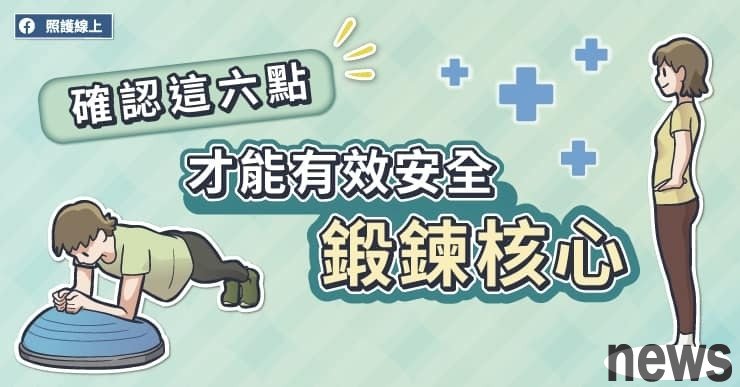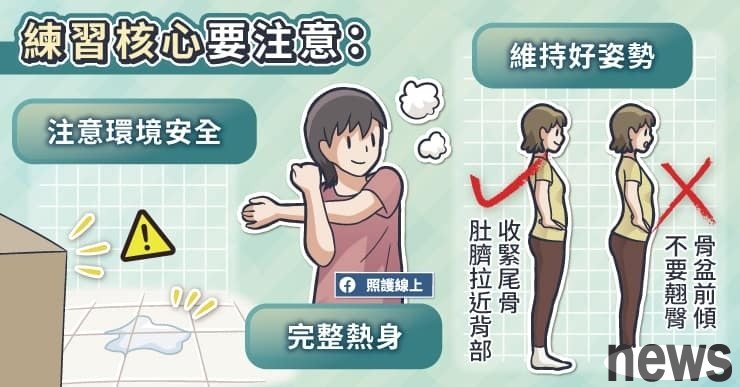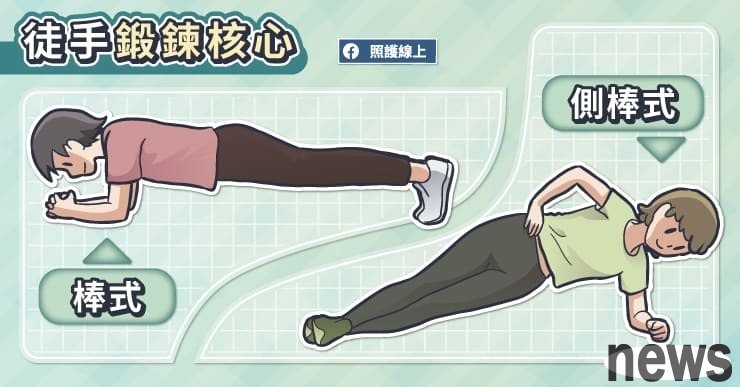
Speaking of the core of the tying, many people will first think of the young people's short tops and the obscure abdominal muscle lines. "Do you have to keep rolling or sitting up to have beautiful abdominal muscle lines?"
However, the actual training core is not the six muscles that focus on the abdomen. In addition to the abdominal muscles, including the muscle groups in the spine, lower back, and hair, that is, this part of the middle of the spine, or "muscle groups other than the head, hands, and feet". These basics that we must use when walking, moving, and exercising every day belong to the scope of the core muscles that need to be worn. When the muscle strength and activity of the core muscle group increase, it will help reduce lower back pain, facial pain, and knee pain.
If you want to start working on the core, please pay attention to the following points:

◆ Pay attention to environmental security
No matter what exercise you are preparing to do, you must first consider safety first. The core tying is not difficult. As long as you have a small space that can place a wall or yoga wall, tidy up around you, swing your hands and turn your body, and make sure you don’t kick the remaining items, it’s a safe environment. Most core sports exercises can be achieved by practicing with bare hands, which means you don’t need to prepare other special equipment to practice.
◆ Complete hot body
If you are only ready to do core training today, you still have to do hot body first. For example, if you step in place for a few minutes, your arms can do some large activities at the same time, such as shoulders turning around and double-handed circles to make your body hot. Or, do some hot body similar to dance movements, let the body do a little activity in every link, and then enter the core exercise.
◆ Maintain a good attitude
When you are trying to fight the core, you often hear the statements like "keep the core" or "core force". If you don't feel it, you can imagine pulling your belly closer and closer to your back and tightening your tailbone. This is the way to close the core. Be careful not to buckle your buttocks and not to bury your pelvis. The curvature from the back to the hips is too large, which can cause problems and make the lower back more susceptible to injury. If a person who usually sits for a long time wants to swell the core, the pelvic front may be swelling because the flexor muscles are too tight. At this time, you can make good use of the flexor tube to relax the flexor muscles first.

◆ There should be no pain during the process
core practice, you will feel the muscles in the core of your abdomen, but it should not be pain. Especially when you are lying down to practice your core, your lower back should be flat on the ground. If you have lower back pain during the process, it is likely that your posture is not correct. Please do not force yourself to continue, but check your movements and adjust them, and then make sure that your lower back is well laid flat on the ground, and do not arch or arch your back. No matter how you do it, it will hurt. The doctor needs to diagnose it and confirm whether there are any other musculoskeletal problems.
◆ Do not over-strengthen the core muscle strength. In addition to exercising the core muscle strength, you should also stretch enough to maintain the flexibility of the muscles. If you have muscle strength but don’t have the flexibility, the core will become unstable. When doing various activities and exercises, you cannot do smooth movements and cannot make the core muscle strength appropriately. In addition, there is no need to practice core muscle strength every day. In fact, during the training of many complex movements, the core will be started. Excessive practice of the core will cause lower back pain and even hernia. Generally, it can be practiced two to three times a week.
◆ Gradually improve the strength of the movement
When you want to strengthen the strength of the core movement, you can do it by strengthening the number of exercises or repeated times. In addition, changing the stability is also a good practice. For example, if you were originally practicing on a flat wall, you could then challenge "unstability". The hip bridge that was originally supported by two feet was changed to single foot support; the rod style of two hands and feet was originally placed on the ground, alternately opening one hand and one foot.
Instability is very helpful for core stimulation, but as we open our heads, all exercises should focus on safety first and reduce the chance of one's injury. Therefore, it is best to challenge the uncertain part after you can do well in the training of the stable plane.
Work the core at home, do a few practices first, balance the kneeling position, and use both hands and knees to the ground. The distance between the two hands is the same width as the shoulders, and the knees just fall below the hair. Retract the muscles in the abdomen, and turn the right hand away from the ground to the same height as the shoulders, with the palm facing down, and then straighten the left foot back and tighten the muscles in the buttocks and thighs. At this time, first maintain the right hand, suck the back, and the left foot at the same level. Only the left hand and right knee are on the ground. Stay for one or two seconds before replying to the original action.

Bending abdomen
Lying on the ground, with both knees bent, and her feet slightly opened and stepped on the ground. Put your arms bent behind your brain. Retreat the abdomen and lift the upper back, bring the ribs closer to the lateral bone, and leave the shoulders off the ground to the ground at about 30 degrees. Slowly exhale when your abdomen is tightened and your body is lifted. Later, slowly lower your back and start to inhale, but do not return to your original position and practice 15 to 20 times in a row.
If you are afraid that you will feel too erect and press your head, you can extend your hands straight forward or cross them in front of your chest. After each continuous practice, if you feel your horny part is a little tight, please lie on the ground and let the horn move to the left and right a few times to relieve your neck..
(Belly Change Practice – Home Training Core)
Rod Style
Rod Style has many alias, such as some people who use "flat plate", "support", "flat plate support" and other methods to call it. The basic action is to lie on the side of the wall, with your elbows directly under your shoulders, and your hips and core forcefully lift your body, leaving only the tip of your feet and the elbows and arms connected to the ground. Do not lower your head or tilt your head, look at the wall about 20-30 cm in front. This is the "elbow-snap stick style". It can also be changed to straighten two hands, and use the palms of both hands to support the ground, and the remaining one does not change. We call this "palm stick style". You can stay for about 30 seconds to 1 minute.
(Rock-style changes allow you to exercise your whole body)
Side Rod-style
Ly lie on the right side first, let your right elbow fall directly below the right shoulder, and your right forearm stick flat against the wall. Keep the knees below the wall, lift the stern and lift the body, so that the stems are in a straight line for 30 seconds. If this action is still simple, it can be changed to double foot support, that is, only the elbows and foot are connected to the wall, and keep the body and legs in a straight line.
Original text: Control low-density pyrosterol, prevent coronary stasis, cardiac specialist doctor's picture and explanation of human bag
Search nearby clinics: Orthopedics, Rehabilitation Department
Free registration, free registration, and easy to use for idling and drug management!
